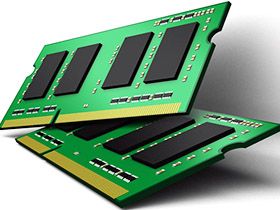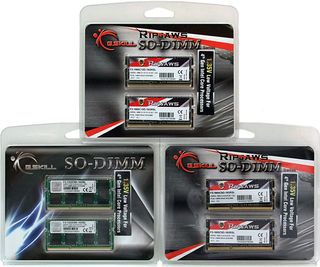Haswell And 1.35 V Memory: Three DDR3 SO-DIMM Kits, Tested
When it comes to memory, most of our focus is on the desktop and its replaceable CPUs. The mobile side typically moves slower. But Intel's Haswell architecture imposes interesting changes, and we saw fit to test SO-DIMMs down at their new 1.35 V ceiling.

Did You Know Mobile Haswell Doesn't Support 1.5 V DDR3?
A straightforward interpretation of the name “Joint Electron Device Engineering Council” tells us a lot about why memory standards improve so slowly. As a multi-member council of memory manufacturing and electronics engineering companies, the standards it sets are defined by ease of adoption. True innovation by one of its members is likely to remain non-standard for months or years as everyone else plays catch-up. Even after a newer standard like DDR3-1600 CAS 9 is finally adopted, most manufacturers revert to older settings, such as DDR3-1600 CAS 11, in order to maintain the highest level of compatibility with previous-generation components.
Of course, this doesn't seem to stifle the enthusiast market. Intel's XMP feature followed Nvidia’s EPP technology to add overclocking profiles on top of the JEDEC-specified table of SPD values. Unfortunately, XMP isn't prolific. Notebooks and tier-one desktops typically don't support the feature, so the potential of high-performance RAM is typically ignored by those machines.
While OEM systems (like the Erazer X700 we just reviewed) continue to restrict RAM selection to SPD settings, Intel’s Haswell architecture more forcefully pushes platform vendors to add JEDEC’s latest standards to their firmware. No doubt, that's largely related to the fact that Intel's mobile Haswell-based CPUs don't support 1.5 V memory.

For enthusiasts upgrading today, this means new systems finally support the rather old DDR3-1866 CAS 10 and DDR3-1600 CAS 9 ratings. In talking to the folks at G.Skill, we agreed that even enthusiasts might not be aware of the changes imposed by Haswell. So, the company sent over some of its low-voltage, high-performance SO-DIMM kits to let us quantify the impact for ourselves.
| G.Skill DDR3 16 GB SO-DIMM Specifications | |||
|---|---|---|---|
| Row 0 - Cell 0 | Data Rate | Primary Latencies | Rated Voltage |
| G.Skill Ripjaws F3-1866C10D-16GRSL | DDR3-1866 | 10-10-10-32 | 1.35 V |
| G.Skill Ripjaws F3-1600C9D-16GRSL | DDR3-1600 | 9-9-9-28 | 1.35 V |
| G.Skill Standard Series F3-1333C9D-16GSL | DDR3-1333 | 9-9-9-24 | 1.35 V |
G.Skill gave us a look a three kits of two 8 GB SO-DIMM modules from basic DDR3-1333 to enhanced DDR3-1866. The most common memory we've run across is DDR3-1600 CAS 11, but we didn’t have any 16 GB kits to compare. Previously, however, we've found similar performance between DDR3-1333 CAS 9 and DDR3-1600 CAS 11, so we’ll soldier on with the parts from G.Skill's care package.
We noticed that the company recently announced a DDR3-2133 Ripjaws SO-DIMM kit, but that it tops out at 8 GB (two 4 GB modules). Hopefully it goes to market with a larger 16 GB version in the future.
Stay on the Cutting Edge
Join the experts who read Tom's Hardware for the inside track on enthusiast PC tech news — and have for over 25 years. We'll send breaking news and in-depth reviews of CPUs, GPUs, AI, maker hardware and more straight to your inbox.
Current page: Did You Know Mobile Haswell Doesn't Support 1.5 V DDR3?
Next Page Ripjaws DDR3-1866 Low Voltage-
Jaroslav Jandek ReplyIt'll be more difficult to explain why the -4770R saw so much less benefit from higher data rates than the -4770K.
The R version has 128MB of L4 cache. At 1280x720, it is large enough for all index and vertex buffers and most textures. That is why main memory speed doesn't significantly affect Iris Pro 5200... -
InvalidError Having 128MB L4 cache certainly skews things around for IGP performance, no surprise there.Reply -
mouse24 Huh, fairly surprised I didn't know about the 1.35v requirement. What happens if you pop in 1.5v in there? Is this just a power savings thing or did intel really mess with their memory controller for laptops?Reply -
Isaiah4110 Wow! I know this article is about memory, but the game benchmark data for Iris Pro actually impresses me quite a bit!Reply -
Crashman Reply
Tell one of these companies that makes upgrade processors to solder the 4770R on an 1150 adapter :)12435372 said:Intel really should've made socketed cpus with Iris Pro
-
zodiacfml AMD must have been very envious with this Iris Pro having embedded 128MB of fast memory....which should be plenty useful for their AMD's APUs.Reply -
de5_Roy Reply
intel claims that the edram costs around $80. that'd jack the a10 6800k price over $200 only to benefit the igpu (possibly the same with gddr5). imo, the weaker cpu cores wouldn't benefit much, if at all. that'd make the apus of poor value and people will argue against the apus claiming you can have a faster configuration under $200 (e.g. core i3 4110/fx6300 + radeon 7770/7750) without requiring the edram. as for core i7 4770R (and other R skus) - it's way too expensive. afaik, brix pro is barebones, the whole pc might cost near $800-1000 fully configured.12436339 said:AMD must have been very envious with this Iris Pro having embedded 128MB of fast memory....which should be plenty useful for their AMD's APUs.
Most Popular


